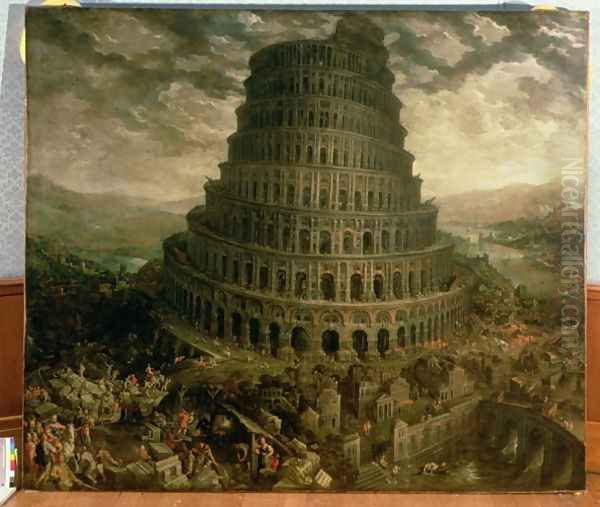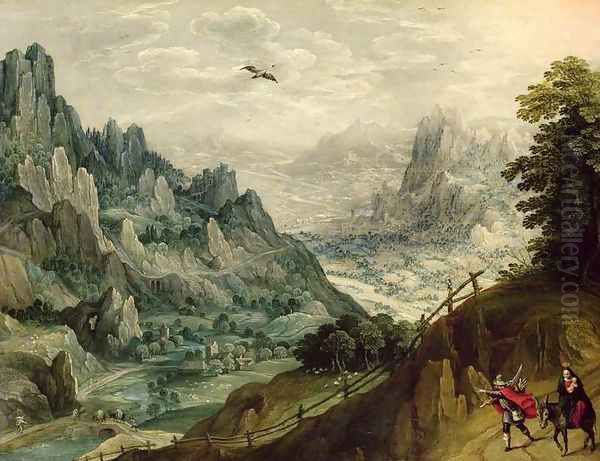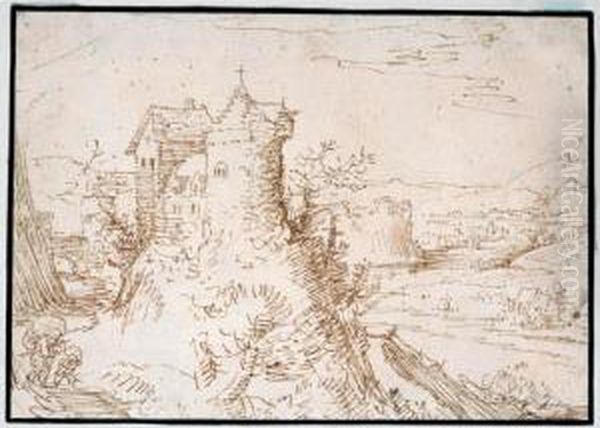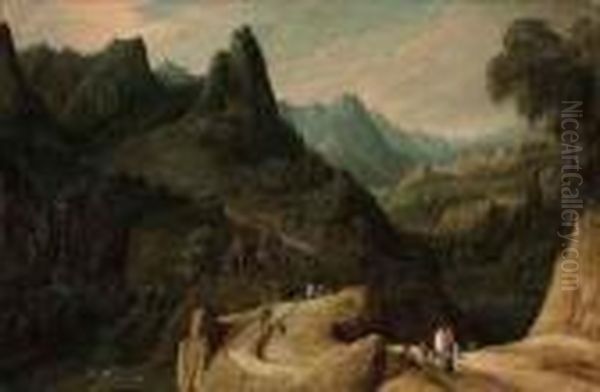Tobias Verhaecht, a significant figure in the Flemish art scene of the late 16th and early 17th centuries, holds a distinct place in the history of landscape painting. Born in Antwerp in 1561 and passing away in the same city in 1631, Verhaecht's career spanned a pivotal period of artistic transition, witnessing the lingering influences of the Northern Renaissance and the burgeoning energy of the Baroque. He is renowned for his imaginative and often dramatic mountain landscapes, and notably, for being the first teacher of the celebrated Peter Paul Rubens.
Early Life and Artistic Genesis in Antwerp
Tobias Verhaecht, whose name is correctly "Verhaecht" rather than the occasional variant "van Haecht," was born into the bustling artistic hub of Antwerp. The city, a major commercial and cultural center, provided a fertile ground for artists. While details of his earliest training are not extensively documented, it is understood that he emerged from a rich local tradition of landscape painting that had been pioneered by figures like Joachim Patinir earlier in the 16th century. Patinir, often credited as one of the first specialist landscape painters in the Netherlands, established the "world landscape" (Weltlandschaft) genre, characterized by panoramic views from a high viewpoint, which would profoundly influence subsequent generations, including Verhaecht.
The artistic environment in Antwerp during Verhaecht's formative years was vibrant. Artists like Pieter Bruegel the Elder, who had died in 1569 but whose influence was immense, had elevated landscape painting to new heights, imbuing it with narrative depth and keen observation of nature and human activity. Though Bruegel's direct impact on Verhaecht's initial training is speculative, the pervasive influence of his innovative approach to landscape composition and subject matter would have been inescapable for any aspiring landscape painter in Antwerp.
The Italian Sojourn: Florence and Rome

Like many ambitious Northern European artists of his time, Verhaecht embarked on a journey to Italy to study both classical antiquity and the works of Italian Renaissance masters. This period was crucial for his artistic development. He is documented as having worked in Florence, where he found favor with the Grand Duke of Tuscany, Francesco I de' Medici. For the Grand Duke, Verhaecht created large-scale landscape paintings, a testament to his growing reputation. His time in Florence would have exposed him to the sophisticated Mannerist art prevalent at the Medici court and the rich tradition of Tuscan landscape depiction.
Following his stay in Florence, Verhaecht traveled to Rome. The Eternal City, with its ancient ruins and the works of High Renaissance masters like Raphael and Michelangelo, offered unparalleled inspiration. In Rome, he reportedly worked as a fresco painter, further diversifying his technical skills. The experience of Italian light, topography, and artistic conventions, while not entirely supplanting his Northern sensibilities, undoubtedly enriched his visual vocabulary and compositional strategies. Artists like Paul Bril, another Fleming who had established a successful career in Rome painting landscapes, were active during this period, and Verhaecht may have encountered his work or even the artist himself, contributing to a cross-pollination of Northern and Italian landscape traditions.
Return to Antwerp and Prominence in the Guild
By 1590, Tobias Verhaecht had returned to his native Antwerp, a mature artist with valuable international experience. In that year, he was enrolled as a master in the Antwerp Guild of Saint Luke, the city's venerable institution for painters, sculptors, and other craftsmen. Membership in the Guild was essential for practicing as an independent master, taking on apprentices, and selling works. His acceptance into the Guild signifies his established status within the Antwerp artistic community.
His workshop soon became active, and he began to cultivate his characteristic style of landscape painting. Verhaecht specialized in mountainous, often fantastical, landscapes. These were not necessarily topographically accurate depictions of specific locations but rather imaginative constructions, often featuring dramatic rock formations, winding rivers, and distant, hazy vistas. This approach was in line with the "world landscape" tradition, but Verhaecht infused it with a personal, sometimes more dramatic or rugged, sensibility. His compositions often employed a high horizon line, allowing for expansive views, and a conventional three-color scheme to create atmospheric perspective: brownish tones in the foreground, greenish hues in the middle ground, and bluish tints for the distant background.
Artistic Style, Influences, and Thematic Repertoire

Tobias Verhaecht's artistic style is firmly rooted in the Flemish landscape tradition of the late 16th century, yet it bears his individual stamp. His primary influence, as mentioned, was the legacy of Pieter Bruegel the Elder, particularly Bruegel's alpine scenes and his method of constructing vast, panoramic landscapes populated by small figures. Verhaecht adopted the high viewpoint and the layered spatial recession typical of Bruegel and earlier pioneers like Joachim Patinir and Herri met de Bles.
His landscapes are often characterized by a sense of grandeur and the sublime, with towering, craggy mountains dominating the composition. These are not tranquil, idyllic scenes but often dynamic and somewhat rugged environments. He frequently incorporated biblical or mythological narratives into his landscapes, with figures, often painted by other artists specializing in staffage, enacting scenes such as the Flight into Egypt, the Temptation of Christ, or mythological hunts. This practice of collaboration between landscape specialists and figure painters was common in Antwerp at the time. Artists like Frans Francken the Younger or Hendrick van Balen were known for their skill in figure painting and often collaborated with landscape painters.
Verhaecht's Italian sojourn, while not leading to a wholesale adoption of Italianate styles, likely refined his sense of composition and perhaps introduced a greater monumentality to his forms. However, his palette and the overall atmosphere of his works remained distinctly Northern. He was less concerned with empirical observation of nature than with creating imaginative, composite views that evoked a sense of awe and wonder. His works often feature winding paths, bridges, castles perched precariously on cliffs, and small figures that emphasize the vastness and power of the natural (or supernatural) world he depicted.
The Teacher of Rubens
One of the most frequently cited facts about Tobias Verhaecht is his role as the first teacher of Peter Paul Rubens. Around 1591 or 1592, the young Rubens, then about fourteen years old, entered Verhaecht's studio. The connection was likely facilitated by family ties: Rubens's mother, Maria Pijpelinckx, had relatives connected to Verhaecht's circle, and later, Rubens's first wife, Isabella Brant, was the niece of Verhaecht's second wife, Susanna van Mockenborch (he was married twice, first to Christina van der Gheen, and after her death, to Susanna van Mockenborch).

Rubens remained with Verhaecht for a relatively short period, perhaps a year or two. While Verhaecht provided Rubens with his initial grounding in the painter's craft, his specialization in landscape painting was not Rubens's primary interest. Rubens soon moved on to study with Adam van Noort, a painter of historical and figure subjects, and then with Otto van Veen, a more classically inclined and intellectually sophisticated artist who had a profound impact on Rubens's development.
Although Verhaecht's direct stylistic influence on Rubens's mature work is considered limited, especially given Rubens's later, transformative engagement with Italian art and classical antiquity, this early tutelage under a respected landscape painter would have provided Rubens with a solid foundation in one of the key genres of Flemish art. Rubens himself would later create powerful landscapes, though stylistically very different from Verhaecht's, demonstrating a lifelong appreciation for the genre.
Notable Works and Artistic Legacy
Among Tobias Verhaecht's most recognized works is his depiction of the Tower of Babel. This biblical subject, popular among Netherlandish artists including Pieter Bruegel the Elder and later Marten van Valckenborch, allowed painters to showcase their skills in architectural rendering, landscape construction, and the depiction of numerous small figures. Verhaecht's versions of this theme, often characterized by a towering, fantastical structure set within an expansive landscape, were highly regarded. One such version was painted during his time in Italy for Grand Duke Francesco I de' Medici, highlighting the international appeal of his work.
Other typical subjects include mountainous landscapes with scenes like The Flight into Egypt, Hunting Scene, or Landscape with Diana and Callisto. These works consistently demonstrate his penchant for dramatic, elevated viewpoints and imaginative geological formations. For example, a Mountain Landscape with River and Travellers would typically feature rugged peaks, a winding river valley, and small figures journeying through the imposing terrain, emphasizing humanity's small scale in relation to the grandeur of nature. His works are found in major museum collections, including the Louvre in Paris and the Musée des Beaux-Arts de Valenciennes, as well as numerous other European and American institutions.
Verhaecht also taught other pupils besides Rubens. Marten Ryckaert (or Rijckiaerts), who later specialized in small-scale, often wooded landscapes, was one of his students. His son, Willem van Haecht (sometimes referred to as Willem van Haecht the Younger to distinguish him from an earlier engraver), also became a painter, though he is better known for his depictions of art collections or "constcamer" paintings, such as the famous Gallery of Cornelis van der Geest.
Contemporaries and the Antwerp Art Scene

Tobias Verhaecht operated within a vibrant and competitive art market in Antwerp. He was a contemporary of many other distinguished landscape painters. Joos de Momper the Younger, for instance, was another leading landscape specialist in Antwerp, known for his often more atmospheric and painterly mountain landscapes, sometimes collaborating with figure painters like Jan Brueghel the Elder. Jan Brueghel the Elder himself, son of Pieter Bruegel the Elder, was a master of detailed, jewel-like landscapes and flower paintings, and his style represented a different, more refined approach to landscape.
Other landscape painters active during Verhaecht's time included Gillis van Coninxloo, whose innovative forest landscapes marked a significant development in the genre, and later, artists like Abraham Govaerts and Alexander Keirincx who further developed forest scenes. While Verhaecht's style remained somewhat more tied to the earlier 16th-century panoramic tradition, he was a respected elder figure in this evolving field. His adherence to a more fantastical and constructed type of landscape distinguished him from the increasing trend towards greater naturalism seen in the work of some of his younger contemporaries. The demand for diverse types of landscapes was high, and Verhaecht's particular specialization found a ready market. He also reportedly designed decorations for Duke Axel of Hungary, indicating a broader range of commissions.
Later Career and Enduring Influence
Tobias Verhaecht continued to paint and maintain his workshop in Antwerp throughout the early decades of the 17th century. While younger artists were pushing landscape painting in new directions—towards greater naturalism, more intimate scenes, or the dramatic dynamism of Rubens's own landscapes—Verhaecht remained largely faithful to his established style. This consistency, however, should not be mistaken for a lack of skill or relevance; his works continued to be appreciated for their imaginative power and decorative qualities.
His influence can be seen primarily in the work of his direct pupils, like Marten Ryckaert, and in the continuation of the "world landscape" tradition, which, although evolving, retained certain core characteristics that Verhaecht championed. His role as Rubens's first teacher, though brief, also secures him a permanent, if modest, place in the narrative of one of art history's giants.

Tobias Verhaecht passed away in Antwerp in 1631. He left behind a substantial body of work that exemplifies a particular moment in the history of Flemish landscape painting—a bridge between the imaginative constructions of the 16th century and the emerging Baroque sensibilities of the 17th. His paintings, with their towering mountains, expansive vistas, and often dramatic compositions, continue to engage viewers with their blend of fantasy and painterly skill. He was a master of a specific type of landscape that, while perhaps less revolutionary than the work of some of his contemporaries like Jan Brueghel the Elder or later Rubens, held an important place in the diverse artistic production of Antwerp.
Conclusion: Verhaecht's Place in Art History
Tobias Verhaecht stands as a notable and skilled practitioner of Flemish landscape painting during a period of significant artistic evolution. His specialization in mountainous, often fantastical "world landscapes" connected him to the legacy of 16th-century masters like Pieter Bruegel the Elder and Joachim Patinir, while his career extended into the era of Baroque dynamism. His Italian travels enriched his art, and upon his return to Antwerp, he established himself as a respected master within the Guild of Saint Luke.
While his most famous connection to posterity is arguably his status as Peter Paul Rubens's first teacher, Verhaecht's own artistic output deserves recognition for its imaginative scope and technical proficiency. His works, characterized by high viewpoints, dramatic rock formations, and the conventional three-color scheme for atmospheric depth, catered to a taste for landscapes that were both decorative and evocative of nature's grandeur. He successfully navigated the competitive Antwerp art market, producing a significant oeuvre and training pupils, including his son Willem van Haecht.
Though perhaps overshadowed by more innovative contemporaries or the colossal figure of his former pupil Rubens, Tobias Verhaecht remains an important artist for understanding the breadth and depth of landscape painting in the Southern Netherlands around the turn of the 17th century. His paintings offer a window into a world where the real and the imagined converged, creating vistas that continue to captivate with their intricate detail and expansive vision. He was a custodian of an established tradition, yet one who infused it with his own distinct, often ruggedly majestic, interpretation of the natural world.